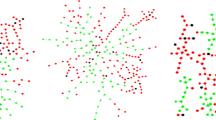Abstract.
We analyze the co-evolution of the performances of firms and of the economy in an evolutionary micro-to-macro model of the Swedish economy. The model emphasizes the interactions between human capital (or competences) and technological change at the firm level and their effects on aggregate growth, taking into account the micro-macro feedbacks. The model features learning-by-doing, incremental and radical innovations, user-producer learning at the firm level, and a change in the techno-economic paradigm. We find that there is an optimal sequence for the firm to allocate their resources: (1) build a general human capital stock before the change in the techno-economic paradigm, (2) spend on R&D, and (3) invest in specific human capital. Innovators fare better than imitators on average, not only because they innovate, but also because they build a competence base, which supports the learning from other firms.
Similar content being viewed by others
Author information
Authors and Affiliations
Rights and permissions
About this article
Cite this article
Ballot, G., Taymaz, E. The dynamics of firms in a micro-to-macro model: The role of training, learning and innovation. J Evol Econ 7, 435–457 (1997). https://doi.org/10.1007/s001910050052
Issue Date:
DOI: https://doi.org/10.1007/s001910050052




